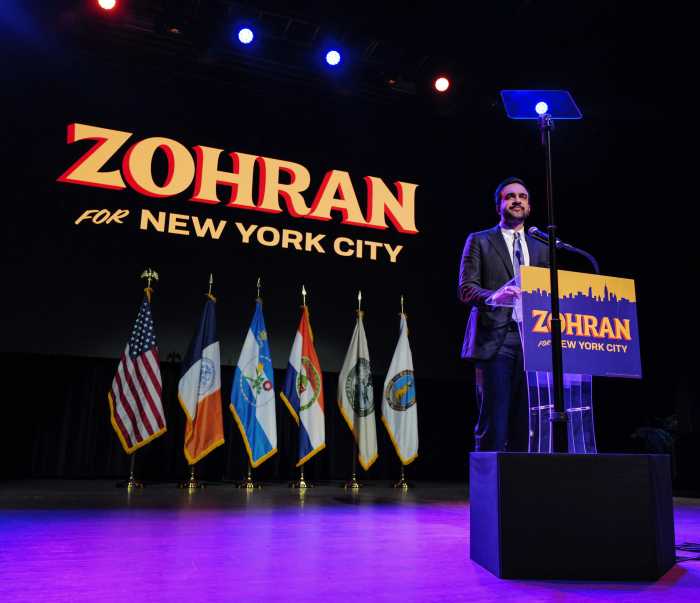The NYPD Mounted Unit’s training facility in Pelham Bay Park in the Bronx doesn’t horse around when it comes to properly training its four and two-legged crime fighters, preparing them for patrolling New York City’s concrete jungle. amNewYork Metro got a behind-the-scenes look into what it takes to become part of one of the NYPD’s elite units.
The NYPD Mounted Unit was established in 1858 to regulate and enforce traffic laws “on horse riders and carriages on the streets of the city.”
Today, the unit, which has about 50 horses, fulfills multiple functions. The “10-foot cops” are regulars at parades, help with crowd control at concerts, protests, and sports events, and serve as a crime deterrent.
Mounted officer and trainer Andi Gjeci shared that the mounted unit was also great for community relations because cops on horses seem more approachable.
“We could be standing in Times Square and, you know, there could be a line of cops there, and for whatever reason, people approach us before they go to the foot post or the patrol police car,” Gjeci said.

His fellow trainer, P.O. Alban Kalaj, added, “We’re definitely good vibe purveyors. People can see us from a mile away on a horse. We stand out visually. You don’t have to look for cops. If you can’t see us, you can definitely hear us coming with the horseshoes clapping on the streets.”
Some advantages of the mounted police are the elevated view and mobility.
“You can see great distances. In New York City, bumper-to-bumper traffic, horses can easily go through those traffic scenarios if, God forbid, we had to ever go through those scenarios,” Kalaj said.
The Mounted Unit only “employs” standardbred horses since thoroughbreds are too spirited and energetic. The police horses in training are thoroughly vetted and usually come from the Bureau of Land Management program, horse rescues, or vendors with contracts with the city -fun fact: all NYPD horses are geldings. The trainers look for horses between five and ten years old who are used to the saddle and have a brave and calm demeanor.
If the highly sensitive creatures meet the necessary requirements, they are trained to handle Gotham’s sounds and sights, and training can take between six months and a year.

“[The training facility] is the foundation where we start training the horses before we take them out to the city because not every horse can tolerate being in New York City or an urban environment,” Kalaj said.
The trainers build the horses’ sensory tolerance by exposing them to audio recordings ranging from bagpipes, helicopters, and car noises to gunfire. They trot through a series of obstacles like a barrel push, curtains, a ball pit, pool noodles, and a colorful wooden platform to build confidence.
Detective Specialist with the Mounted Unit, Kristopher E. Christensen, explained that everything was an obstacle to a horse.
“The more obstacles or things you “throw” at them, the more confidence you’re going to build,” Christensen said.
Once the officers feel the horses are confident enough to handle noises and obstacles without getting spooked, they take the equines out on their first patrol in the Bronx.

“Then, when [the horses] are doing well on these streets, we start to change the atmosphere. We take them to Manhattan, take them to Coney Island, [and] into Queens. We take them everywhere. We go to Staten Island. We’re a city-wide unit,” Kalaj said.
Currently, six NYPD mounted police officers are going through the “School of Horsemanship,” which lasts three to six months. Officers who apply to become part of the highly sought-after unit, which operates under the Special Operations Bureau, don’t have to have equestrian experience but should be unafraid of horses and love being around animals. A positive attitude and strong work ethic are also a huge plus.
“Horses are so in tune with their environment. So if you’re a nervous person or if you’re nervous around the horse, they’re going to know that,” Gjeci said.
Kalaj didn’t have any experience with horses when he joined the prestigious unit almost seven years ago.
“I’ve never been around horses,” Kalaj said. “I was very intimidated when I first got here, but now it’s extremely comfortable, and I’m probably too comfortable now. This is something new to a lot of people.”

The mounted cops in training first learn basics like stable safety, grooming the horse, how to saddle, placing the bit, bridle, and reins, and hand-walk them to get used to being around horses before learning in-depth riding skills like trotting and cantering, reading a horse’s body language, and how to push a horse forward.
“Working with animals, it’s just relaxing. It’s just calming. Winston Churchill says the best thing for the inside of a person is the outside of a horse,” said Kajal, describing his job with the mounted unit as a “blessing.”
“There’s something to be said about horses,” Gjeci said. “They do really just bring positive energy, and you know, they really are therapeutic.”
One of Gjeci’s most memorable moments with the Mounted Unit was when they rescued a 17-year-old horse from drowning in Orchard Beach last year.
The horse was stuck in mud up to its chest, and thanks to a team effort between ESU, Mounting, Harbor, and Aviation, the horse was pulled to safety.
“We responded with our large animal rescue equipment. Obviously, it was a team effort. But we were able to use our equipment and rescue that horse. When we showed up, it wasn’t looking good. But by chance, he pulled through, and he actually got back on his feet,” Gjeci recalled.












































